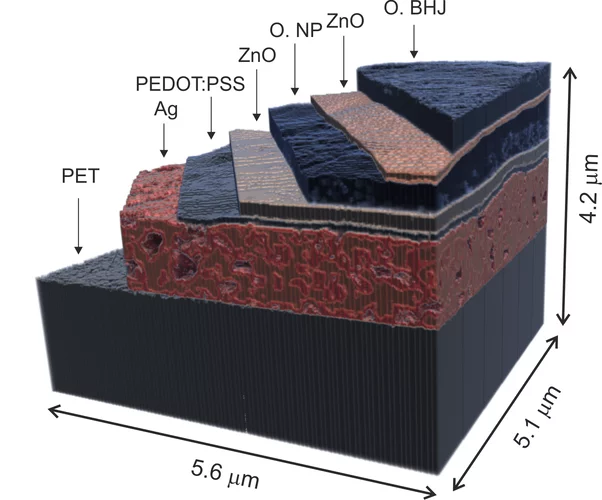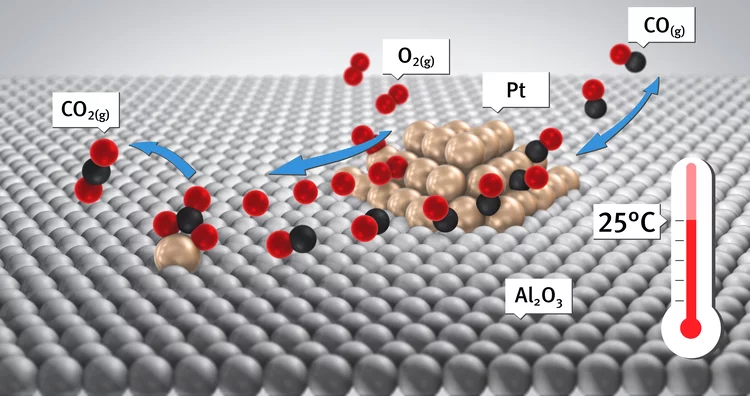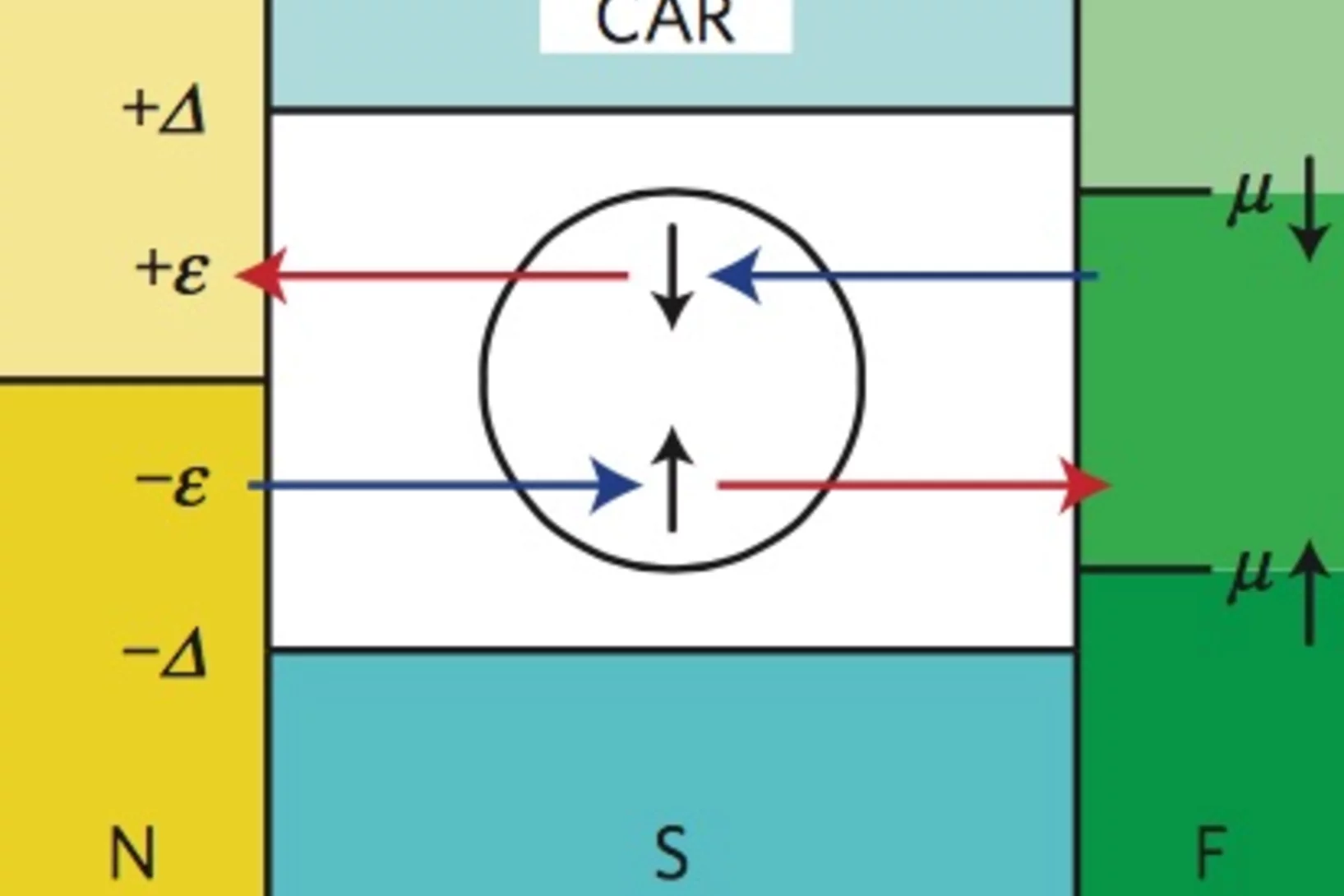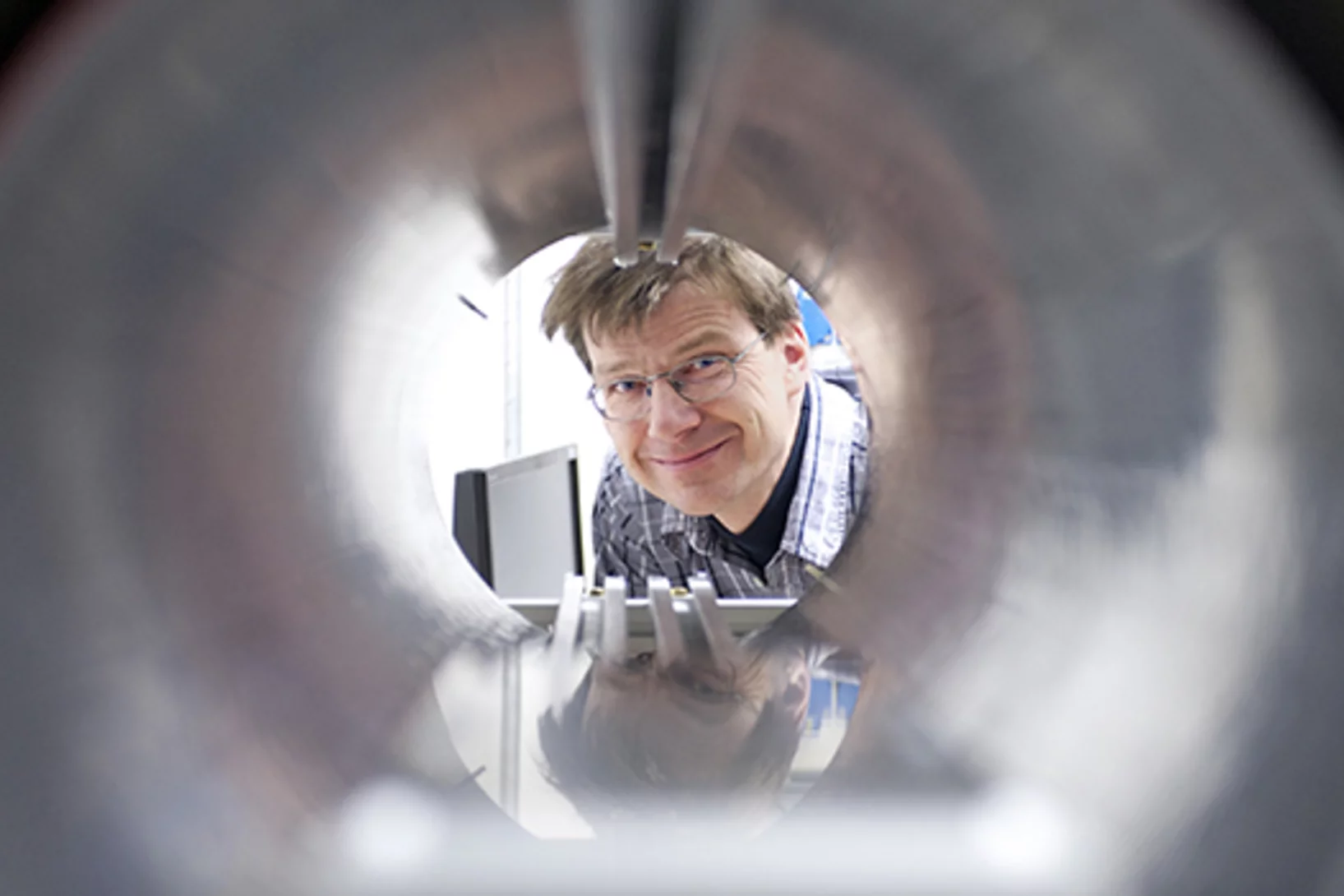Am PSI widmen sich mehrere Projekte wichtigen Forschungsfragen rund um das Coronavirus Sars-CoV-2 und den daraus resultierenden Erkrankungen. Wir informieren über Aktivitäten und Vorhaben, zum Beispiel zu Untersuchungen von Lungengewebe, zur Produktion von Proteinen und Antikörpern oder über Ideen für neue Forschung zu Covid-19.
Nützliche Links
Observation of Fermi-Arc Spin Texture in TaAs
The study of nontrivial topological semimetals (TSM) is an emerging subject, providing a new frontier in topological aspects beyond insulators. Here, we have investigated the spin texture of surface Fermi arcs in the recently discovered Weyl semimetal TaAs using spin- and angle-resolved photoemission spectroscopy. The experimental results demonstrate that the Fermi arcs are spin polarized. The measured spin texture fulfills the requirement of mirror and time-reversal symmetries and is well reproduced by our first-principles calculations, which gives strong evidence for the topologically nontrivial Weyl semimetal state in TaAs. The consistency between the experimental and calculated results further confirms the distribution of chirality of the Weyl nodes determined by first principles calculations.
Excited states at interfaces of a metal-supported ultrathin oxide film
At the PEARL beamline, metal-supported ultrathin oxide films have been studied which are a class of materials of technological importance in various research fields such as catalysis, spintronics, or nanoelectronics.
Nationaler Zukunftstag 2015
Am Nationalen Zukunftstag 2015 durften wir 55 Mädchen und 56 Jungs am PSI begrüssen. Die 111 Kinder konnten aus den angebotenen 11 Stationen (Berech¬nungs-ingenieur, Chemieingenieure, Chemielaboranten, Elektroniker, Fachfrauen Betreuung, Metallographen, Physiker, Physiklaboranten, Strukturbiologen, Techn. Laborassistenten und iLab), jeweils zwei auswählen und diese beiden an einem halben Tag besichtigen.
Cousin des Elektrons nach 86 Jahren gefunden
Physiker des Paul Scherrer Instituts PSI gemeinsam mit Kollegen aus China sowie von der ETH Zürich und der ETH Lausanne EPFL haben bei Versuchen an der Synchrotron Lichtquelle Schweiz SLS ein Teilchen nachgewiesen, dessen Existenz bereits vor 86 Jahren vorausgesagt worden war. Es handelt sich um ein Mitglied der Teilchenfamilie, zu denen auch das Elektron, der Träger elektrischer Ströme, gehört. Anders als das Elektron hat das neue Teilchen aber keine Masse und es kommt nur in einer bestimmten Klasse von Materialien vor, die als Weyl-Halbmetalle bezeichnet werden.
X-ray nanotomography aids the production of eco-friendly solar cells
Polymer solar cells are in the spotlight for sustainable energy production of the future. Characterization of these devices by X-ray nanotomography helps to improve their production using environmentally friendly materials.
Strong enhancement of s-wave superconductivity near a quantum critical point of Ca3Ir4Sn13
We report microscopic studies by muon spin rotation/relaxation as a function of pressure of the Ca3Ir4Sn13 and Sr3Ir4Sn13 cubic compounds, which are members of the (Ca1−xSrx)3Ir4Sn13 system displaying superconductivity and a structural phase transition associated with the formation of a charge density wave (CDW).
Controlling tunnelling in methane loss from acetone ions by deuteration
At the imaging Photoelectron Photoion Coincidence (iPEPICO) endstation of the VUV beamline evidence of H-atom tunneling was shown.
Direct evidence for a pressure-induced nodal superconducting gap in the Ba0.65Rb0.35Fe2As2 superconductor
The superconducting gap structure in iron-based high-temperature superconductors (Fe-HTSs) is non-universal. In contrast to other unconventional superconductors, in the Fe-HTSs both d-wave and extended s-wave pairing symmetries are close in energy. Probing the proximity between these very different superconducting states and identifying experi- mental parameters that can tune them is of central interest.
Intrinsic Paramagnetic Meissner Effect Due to s-Wave Odd-Frequency Superconductivity
In 1933, Meissner and Ochsenfeld reported the expulsion of magnetic flux - the diamagnetic Meissner effect - from the interior of superconducting lead. This discovery was crucial in formulating the Bardeen-Cooper-Schrieffer (BCS) theory of superconductivity. In exotic superconducting systems BCS theory does not strictly apply.
New EU project: Guiding light for the world's brightest light sources
EUCALL will build bridges between major laser and X-ray research centres: For the past half-century, two special kinds of light have changed the landscape of research. Advanced visible-spectrum optical lasers have propelled studies into ultrafast processes, new materials, telecommunications, and many other fields, while intense X-rays produced at synchrotrons have helped image tiny structures and otherwise invisible parts of matter, enabling huge leaps in biochemistry, pharmacology, and materials science. New developments have enhanced the generation of X-rays at optical-laser and accelerator facilities, resulting in the creation of large international research centres. The European Union is now funding a 7 million-euro effort to bring these research centres together through the European Cluster of Advanced Laser Light Sources (EUCALL) project.
Visualizing the morphology of vortex lattice domains in a bulk type-II superconductor
Alike materials in the solid state, the phase diagram of type-II superconductors exhibit crystalline, amorphous, liquid and spatially inhomogeneous phases. The multitude of different phases of vortex matter has thence proven to act as almost ideal model system for the study of both the underlying properties of superconductivity but also of general phenomena such as domain nucleation and morphology.
Struktur der Betonkrankheit
entschlüsselt
Wenn Brücken, Staumauern und andere Bauwerke aus Beton nach einigen Jahrzehnten von dunklen Rissen durchzogen sind, dann ist die sogenannte Betonkrankheit die Ursache. Wie das Material, das in diesen Rissen entsteht, auf der Ebene einzelner Atome aufgebaut ist, haben jetzt Forschende des Paul Scherrer Instituts PSI und der Empa entschlüsselt - und dabei eine bislang unbekannte kristalline Anordnung der Atome entdeckt.
Visualizing the morphology of vortex lattice domains in a bulk type-II superconductor
Alike materials in the solid state, the phase diagram of type-II superconductors exhibit crystalline, amorphous, liquid and spatially inhomogeneous phases. The multitude of different phases of vortex matter has thence proven to act as almost ideal model system for the study of both the underlying properties of superconductivity but also of general phenomena such as domain nucleation and morphology.
Röntgenforschung im Ufo
Die Synchrotron Lichtquelle Schweiz SLS fällt zuerst durch ihr markantes Gebäude auf. Innen beeindruckt sie mit Spitzenforschung. Ein Streifzug durch die Welt, in der Elektronen Slalomkurse einlegen und Röntgenstrahlen Proteine entschlüsseln.
New methods to generate short and high-power X-ray Free-Electron-Laser pulses
State-of-the-art X-ray Free-Electron-Laser (XFEL) facilities like SwissFEL are able to provide radiation pulses with pulse powers of a few tens of gigawatts and pulse durations of several tens of femtoseconds and shorter. There is, however, a strong demand in research fields such as bioimaging and nonlinear optics to obtain higher radiation powers and shorter pulses than in standard facilities. In this context, we have developed two new methods able to generate terawatt-attosecond XFEL pulses. Both proposals are based on superradiance, a regime with quadratic growth of the radiation power and a shortening of the spike while it slips into unspoiled (good-beam) regions of the bunch.
Put in perspective
Researchers from the Paul Scherrer Institute PSI have succeeded in using commercially available camera technology to visualise terahertz light. In doing so, they are enabling a low-cost alternative to the procedure available to date, whilst simultaneously increasing the comparative image resolution by a factor of 25. The special properties of terahertz light make it potentially advantageous for many applications, from safety technology to medical diagnostics.
Methane storage in flexible metal–organic frameworks with intrinsic thermal management
As a cleaner, cheaper, and more globally evenly distributed fuel, natural gas has considerable environmental, economic, and political advantages over petroleum as a source of energy for the transportation sector. Despite these benefits, its low volumetric energy density at ambient temperature and moderate pressure presents substantial challenges, particularly for light-duty vehicles with little space available for on-board fuel storage.
Ins rechte Licht gerückt
Forschende des Paul Scherrer Instituts PSI konnten mit handelsüblicher Kamera-Technologie Terahertzlicht visualisieren. Damit eröffnen sie nicht nur eine kostengünstige Alternative zum bisher üblichen Verfahren. Auch die Bildauflösung konnten sie im Vergleich um das 25-Fache verbessern. Durch seine besonderen Eigenschaften ist Terahertzlicht für viele Anwendungen interessant. Am PSI wird es bei den Experimenten am Freie-Elektronen-Röntgenlaser SwissFEL zum Einsatz kommen.
Room-temperature carbon monoxide oxidation by oxygen over Pt-Al2O3 mediated by reactive platinum carbonates
A new possibility for the attainment of low-temperature oxidation of carbon monoxide is demonstrated. Here we report using time-resolved DRIFTS, XAS, and mass spectrometry a platinum carbonate-mediated mechanism for the room-temperature oxidation of carbon monoxide.
Interfacial Control of Magnetic Properties at LaMnO3/LaNiO3 heterostructures
Using a X-ray magnetic circular dichroism measured at the X-Treme beamline, SLS, in conjunction with X-ray reflectivity measured at the SEXTANTS beamline, SOLEIL, the authors show that the degree of intermixing at the monolayer scale allows interface-driven properties such as charge transfer and the induced magnetic moment in the nickelate layer to be controlled.
Robustes Röntgengerät für Entwicklungsländer
Das Paul Scherrer Institut PSI ist an einem Projekt mehrerer Forschungsinstitute (unter Leitung der EPFL) beteiligt, ein Röntgengerät speziell für Entwicklungsländer zu entwickeln. Das Gerät soll mit tropischem Klima zurechtkommen sowie einfach zu reparieren und kostengünstig sein. PSI-Forschende konzentrieren sich dabei auf das Herstellen eines kostengünstigen Detektors, der für die Bildaufnahmen benötigt wird. Vergleichbar mit einem Chip in einer Digitalkamera registriert der Detektor das Röntgenlicht.
Fermi states and anisotropy of Brillouin zone scattering in the decagonal Al–Ni–Co quasicrystal
Quasicrystals (QCs) are intermetallic alloys where excellent long-range order coexists with lack of translational symmetry in one or more dimensions. These materials have a high potential in application as a material for a solar cells, hydrogen storage applications, heat insulating layers, and others.
Observation of Gravitationally Induced Vertical Striation of Polarized Ultracold Neutrons by Spin-Echo Spectroscopy
We describe a spin-echo method for ultracold neutrons (UCNs) confined in a precession chamber and exposed to a |B0| = 1μT magnetic field. We have demonstrated that the analysis of UCN spin-echo resonance signals in combination with knowledge of the ambient magnetic field provides an excellent method by which to reconstruct the energy spectrum of a confined ensemble of neutrons.
Response of Plasma-Polymerized Hexamethyldisiloxane Films to Aqueous Environments
Thin plasma polymer films were deposited in hexamethyldisiloxane (HMDSO) and HMDSO/O2 low-pressure discharges and their chemical structures analyzed using infrared (IR) spectroscopy and neutron reflectometry (NR). The (plasma-polymerized) ppHMDSO film exhibits hydrophobic, poly(dimethylsiloxane)-like properties, while the retention of carbon groups is reduced by O2 addition, yielding a more inorganic, hydrophilic ppSiOx film.
Robuster dank Abweichungen
Mikroskopische Abweichungen von der idealen Struktur machen den KKW-Brennstoff Urandioxid widerstandsfähiger gegen Strahlungsschäden.
2015 Otto Kratky award
Marianne Liebi was awarded the 2015 Otto Kratky award by the Helmholtz-Centre Berlin for excellence in the field of small-angle X-ray scattering (SAXS) analysis. The award was bestowed in the last SAS2015 conference in Berlin. Marianne is a postdoctoral fellow in the coherent X-ray scattering group (CXS) in PSI, carrying out research in scanning SAXS measurement and analysis in 2D and 3D. Image credit ©HZB/Michael Setzpfandt
Remotely induced magnetism in a normal metal using a superconducting spin-valve
Superconducting spintronics has emerged in the past decade as a promising new field that seeks to open a new dimension for nanoelectronics by utilizing the internal spin structure of the superconducting Cooper pair as a new degree of freedom. Its basic building blocks are spin-triplet Cooper pairs with equally aligned spins, which are promoted by proximity of a conventional superconductor to a ferromagnetic material with inhomogeneous macroscopic magnetization.
Neue Methode wird bisher genaueste Vermessung von Neutronen ermöglichen
Unser Universum besteht aus deutlich mehr Materie, als sich mit bisherigen Theorien erklären lässt. Dieser Umstand ist eines der grössten Rätsel der modernen Wissenschaft. Ein Weg, diese Unstimmigkeit zu klären, führt über das sogenannte elektrische Dipolmoment des Neutrons. Forschende am PSI haben in einer internationalen Zusammenarbeit eine neue Methode entwickelt, die helfen wird, dieses Dipolmoment genauer als je zuvor zu bestimmen.
Perfekte Strahllinien merkt man nicht
Interview mit Luc PattheyLuc Patthey ist für das Design und die Umsetzung der Strahllinien für den Freie-Elektronen-Röntgenlaser SwissFEL verantwortlich. Im Interview erklärt er, welche Anforderungen die Strahllinien erfüllen müssen, damit die vom SwissFEL erzeugten Röntgenlichtpulse in der optimalen Form zu den Experimenten gelangen und welche Rolle Kooperationen bei der Entwicklung von Strahllinien spielen.
Wasserkanäle machen Brennstoffzellen effizienter
Forschende des Paul Scherrer Instituts PSI haben im Labor ein Beschichtungsverfahren entwickelt, das die Effizienz von Brennstoffzellen erhöhen könnte. Das für die Massenproduktion geeignete Verfahren haben die PSI-Wissenschaftler bereits zum Patent angemeldet.






























